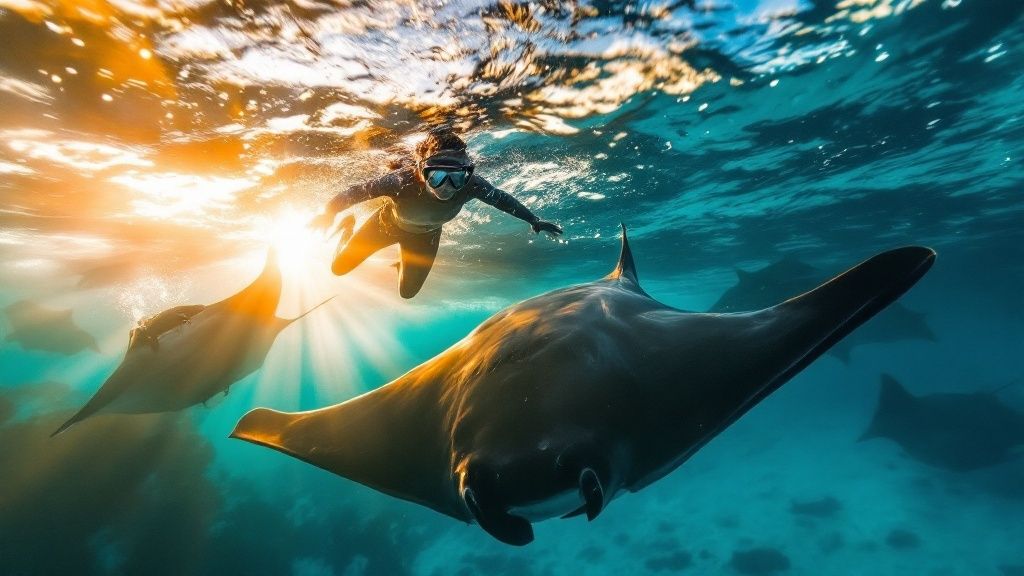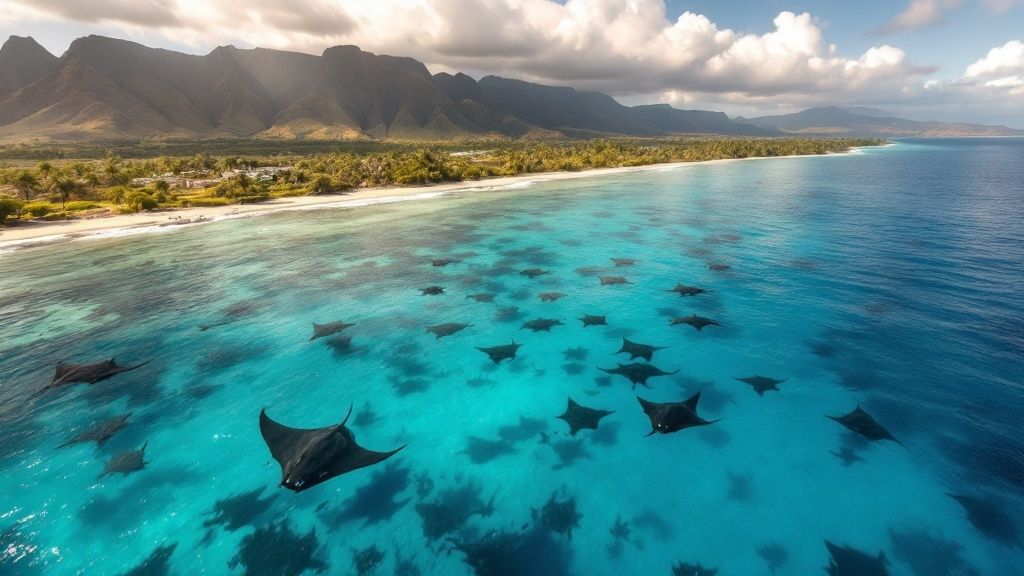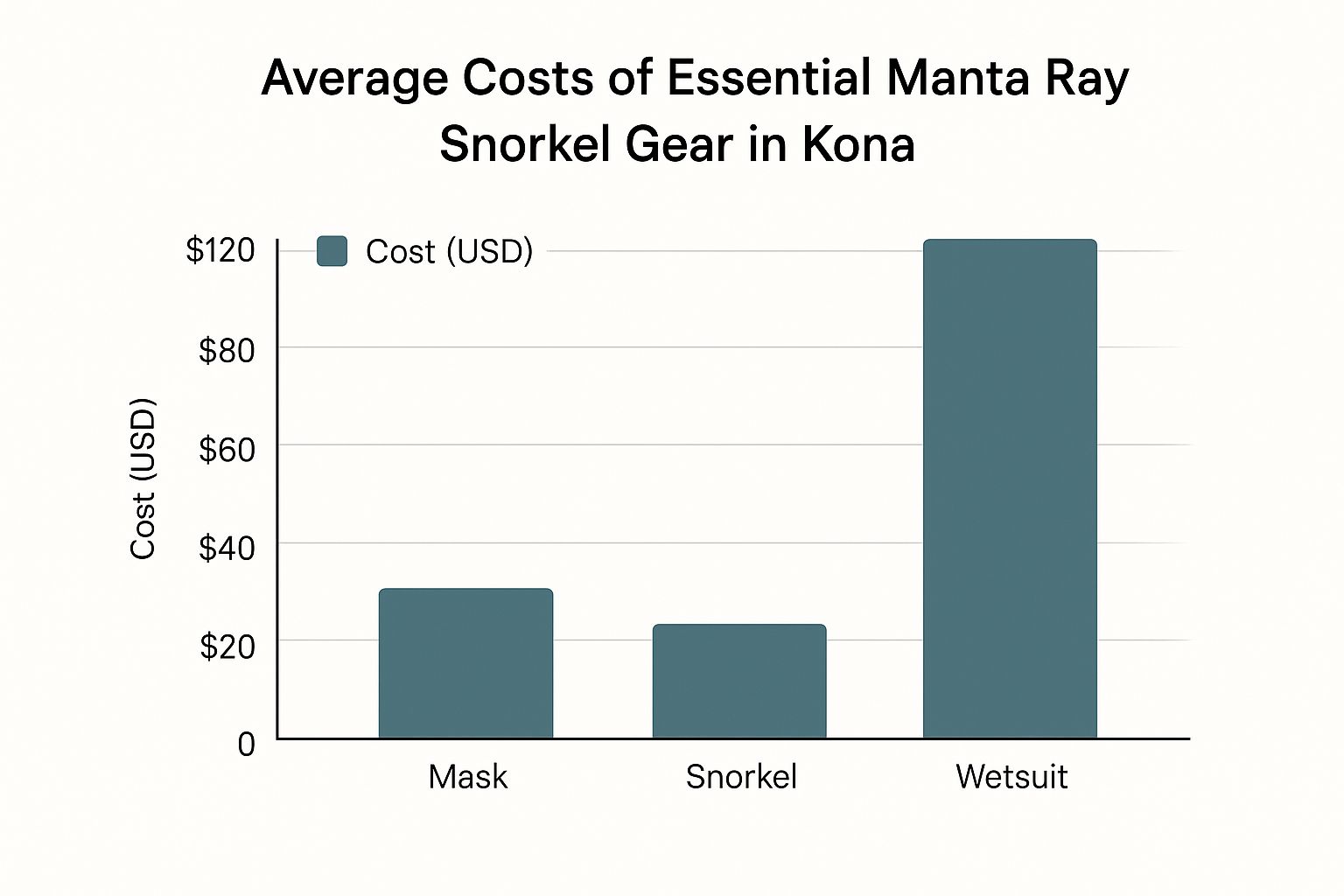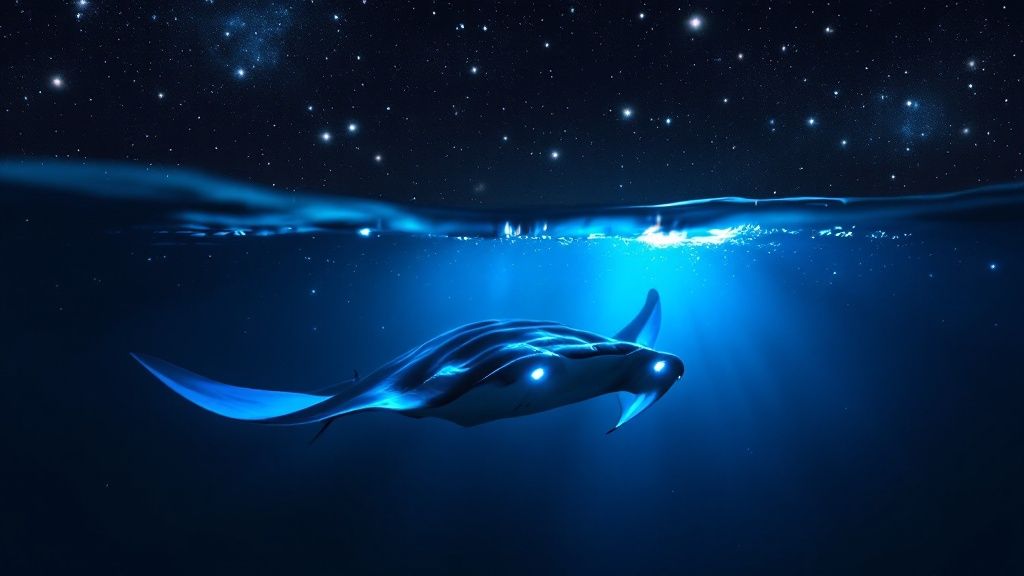Manta Ray Snorkel Kona: Experience Hawaii’s Best Adventure
- Byron
- May 19
- 10 min read
Why Kona's Manta Ray Encounters Are World-Class
Kona, Hawaii, isn't just another island paradise; it's a world-renowned hotspot for manta ray encounters. The unique combination of volcanic formations and nutrient-rich currents creates a perfect feeding ground for these gentle giants. This reliable food source keeps the manta rays coming back year after year, providing incredible opportunities for visitors to witness their graceful ballet. And these aren't just quick glimpses. Kona boasts remarkably high sighting rates.
In fact, Kona, Hawaii, is famous for its consistent manta ray sightings, estimated between 80 to 90% year-round. This reliability, combined with the chance to observe their captivating feeding habits, attracts roughly 80,000 snorkelers annually. Find more detailed statistics here.
The Magic of Kona's Underwater Landscape
The volcanic origins of the Hawaiian Islands have shaped an underwater world like no other. Submerged lava flows create a dramatic setting for the manta rays, forming crevices and ledges teeming with smaller marine life. This rich biodiversity fuels the plankton blooms that attract the manta rays. Plankton, these tiny organisms drifting in the current, are the main food source for these filter-feeding giants.
Imagine a massive, graceful manta ray, its wingspan reaching up to 12 feet, effortlessly gliding through the water, filtering these microscopic organisms. It's a truly mesmerizing sight.

The Manta Ray-Kona Connection
Over time, Kona's manta rays seem to have developed a special bond with the island's human visitors. They appear comfortable feeding near snorkelers and divers, creating an intimate and unforgettable encounter. This isn't just a chance meeting; it's a carefully orchestrated natural phenomenon. The clear, warm waters around Kona enhance visibility, providing stunning views of these magnificent creatures. You might be interested in: How to master the manta ray snorkel Kona experience.
A Bucket-List Adventure for a Reason
Kona's manta ray snorkel isn't just another tourist activity; it's a truly special experience. The combination of consistent sightings, clear waters, and the unique underwater landscape makes it world-class. Travelers come from all over the world for this specific encounter, a testament to its extraordinary appeal. For those seeking an awe-inspiring adventure, the chance to witness these gentle giants in their natural habitat is a moment of pure magic that only Kona can provide.
Prime Spots for Manta Magic Around the Big Island

Kona, Hawaii, is a premier destination for manta ray snorkeling. But with several locations to choose from, knowing the best spots truly elevates the experience. Two exceptional choices are Manta Village and Keauhou Bay, each offering distinct advantages for observing these graceful creatures. Understanding these differences helps you select the perfect spot for your manta ray adventure.
Manta Village: A Shallow Wonderland
Just off the coast of the Kona International Airport, Manta Village is renowned for its shallow, sandy bottom. This creates optimal viewing conditions, especially for those new to snorkeling. The relatively calm waters and plentiful plankton blooms draw in numerous manta rays. During peak season, it's not uncommon to witness several mantas feeding simultaneously, a truly mesmerizing sight.
Keauhou Bay: A Deeper Dive
South of Kona lies Keauhou Bay, another celebrated manta ray haven. The waters here are slightly deeper, providing a different perspective. The bay's diverse topography, with rocky outcrops and vibrant coral formations, offers a richer underwater landscape. This varied terrain can, however, present a slightly greater challenge for beginner snorkelers.
To help you choose between these amazing locations, here’s a comparison table:
Top Manta Ray Snorkeling Locations in Kona
Location | Success Rate | Best Time | Water Conditions | Special Features |
|---|---|---|---|---|
Manta Village | High | Sunset - Night | Calm, Shallow | Ideal for beginners, excellent visibility |
Keauhou Bay | High | Sunset - Night | Slightly Deeper, Variable Currents | Diverse underwater terrain, potential for more advanced snorkeling |
As you can see, both locations offer a high probability of encountering manta rays. Manta Village provides a user-friendly environment for beginners, while Keauhou Bay offers a more adventurous experience for seasoned snorkelers.
Manta rays are truly impressive creatures. Some individuals in Kona boast wingspans reaching up to 12 feet. Their sheer size, coupled with their graceful ballet through the water, makes snorkeling with them utterly captivating. The rich waters around Kona teem with plankton, the manta rays' primary food source, attracting them to locations like Keauhou Bay.
Choosing the Right Spot: Factors to Consider
Choosing the best spot depends on several key factors. Water conditions are paramount. Experienced guides carefully assess current strength and visibility to select the optimal location for each outing. The time of year also influences manta ray activity in different areas.
The cultural and ecological significance of manta rays in Kona is substantial. Many tour operators prioritize both visitor safety and environmental responsibility during snorkeling excursions. Learn more about this important topic.
While Kona offers incredible snorkeling, the world is full of amazing destinations. Planning a trip elsewhere? You might find this resource useful: rent a car in Punta Cana. Back in Kona, photographers should consider lighting and water depth. Manta Village's shallow waters allow for excellent natural light, creating perfect conditions for capturing stunning images. So, whether you're a novice or a seasoned snorkeler, understanding these nuances can help you make the most of your manta ray encounter.
Day vs. Night Encounters: Two Different Worlds
Choosing between a day and night manta ray snorkel in Kona is like choosing between two distinct adventures. Both offer incredible views of these gentle giants, but the experiences are unique. Understanding the differences will help you choose the best adventure for you. Interested in a magical nighttime encounter? Learn more about magical night encounters.
The Sunlit Dance of Daytime Encounters
During the day, manta rays gracefully glide through the clear, sunlit ocean. They feed on plankton near the surface, offering excellent visibility and easy observation of their natural behaviors. The daytime setting provides a calm and tranquil snorkeling experience. However, the manta rays may be less concentrated as they roam across wider areas.
The Electric Ballet of Nighttime Encounters
As night falls, the manta ray experience transforms. Dive lights attract plankton, drawing the manta rays closer to the surface and in greater numbers. This creates a mesmerizing underwater ballet, illuminated by the lights. From 2009-2014, Manta Ray Advocates Hawaii collected data, including individual tracking and monthly statistics, revealing insights about manta ray habitat patterns along the Kona Coast.
Visibility, Temperature, and the Psychological Experience
While nighttime visibility is limited to the area illuminated by the lights, this focused view highlights the manta rays’ movements and feeding. The water temperature can be cooler at night, so a wetsuit is recommended for comfort. Being in the ocean at night, surrounded by these magnificent creatures, creates a sense of awe and mystery.

This infographic shows the average costs of essential manta ray snorkel gear in Kona. A mask costs around $60, a snorkel around $30, and a wetsuit around $120. Getting the right gear requires a moderate investment.
To help you choose your ideal experience, let's compare day and night snorkeling:
To help you visualize the key differences, here's a comparison table:
Day vs. Night Manta Ray Snorkeling Comparison: A detailed comparison of daytime and nighttime manta ray snorkeling experiences in Kona.
Feature | Day Experience | Night Experience | Best For |
|---|---|---|---|
Visibility | Wider range, natural light | Focused on illuminated area | Those who prefer natural light vs. dramatic lighting |
Manta Ray Behavior | Natural feeding patterns, roaming | Concentrated feeding, closer encounters | Observing natural behavior vs. dynamic interactions |
Ambiance | Calm, tranquil | Exciting, awe-inspiring | Relaxation vs. adventure |
Water Temperature | Generally warmer | Can be cooler | Those sensitive to cold vs. those comfortable with a wetsuit |
Photography | Natural light photography | Requires specialized night photography techniques | Natural light shots vs. dramatic low-light captures |
Crowd Levels | Can be less crowded | Potentially more crowded due to popularity | Those seeking solitude vs. vibrant group experiences |
This table highlights the core differences between day and night manta ray snorkeling, allowing you to select the experience that best aligns with your preferences.
Choosing Your Ideal Manta Ray Adventure
The best choice depends on your individual preferences. Do you prefer the daytime's calm serenity or the nighttime's electric energy? Consider your comfort level in the water, especially at night, and your photography goals. Daytime provides natural light for vibrant photos, while nighttime requires specific techniques for capturing the illuminated spectacle. Weighing these factors will ensure an unforgettable manta ray snorkel experience in Kona.
Preparing for Your Manta Adventure Like a Pro

Turning your manta ray snorkel Kona trip into a truly magical experience starts with good planning. This goes beyond just booking the tour. It includes everything from being physically prepared and choosing the right gear to handling any pre-trip jitters. This guide, created with insights from experienced travelers and local experts, will give you everything you need to know for a truly unforgettable encounter.
Gear Up for Success: Essentials and Comfort Tips
Let's start with what to bring. A comfortable, well-fitting mask and snorkel are essential for a clear view underwater. If your mask tends to fog up, think about using an anti-fog solution or try a simple trick like rubbing the inside with toothpaste and rinsing it out. A wetsuit is key for staying warm, especially if you're going night snorkeling. While rentals are available, many people prefer the fit and feel of their own.
Mask and Snorkel: Make sure they fit well to avoid leaks and discomfort.
Wetsuit: Keeps you warm, which is especially important for night excursions.
Anti-fog Solution: Keeps your mask clear for optimal underwater viewing.
Reef-Safe Sunscreen: Protects both your skin and the delicate coral.
Don't forget a waterproof camera to document your adventure. If you're bringing your own, make sure it's safely tucked away in a waterproof housing. Get familiar with the settings beforehand so you're ready to capture those amazing underwater shots.
Managing Motion Sickness and Other Concerns
Motion sickness can put a damper on any ocean adventure. If you're prone to seasickness, take precautions like ginger candies or over-the-counter medication before your tour. Staying hydrated and focusing on the horizon can also help. Many people prefer night encounters for the increased manta ray activity, which you can read more about on the Night Manta Ray Snorkel Kona page.
Addressing Common Anxieties
First-time snorkelers often have concerns about their swimming abilities, night snorkeling, or encountering wildlife. Don't worry! Most manta ray snorkel tours accommodate all swimming levels. Certified lifeguards are there to provide support and ensure your safety throughout the experience. Night snorkeling might feel a little strange at first, but the focused lights on the manta rays offer a reassuring point of reference.
Remember, manta rays are gentle filter feeders and pose no danger to humans. Respecting their space and following your guide’s instructions will ensure a safe and enriching encounter for everyone. Check out these helpful tips: How to master manta ray snorkeling.
Small Details, Big Impact: Comfort and Convenience
Finally, think about the small things that can make a big difference in your comfort and enjoyment. A dry bag protects your valuables, and a towel will feel great after your snorkel. Packing a light snack and water can help ward off hunger and dehydration after your adventure. These small preparations can significantly enhance your overall enjoyment of this incredible experience. By taking care of these practicalities and addressing any pre-trip nerves, you’ll be ready to fully embrace the magic of your manta ray snorkel Kona adventure.
Selecting Your Perfect Manta Tour: Beyond the Basics
Choosing the right tour operator can significantly impact your manta ray snorkel Kona experience. Price is definitely a factor, but several other key elements contribute to a truly memorable and ethical encounter. Drawing on insights from marine biologists and seasoned travelers, let's explore the crucial considerations that go beyond the advertised price.
Boat Stability and Guide Expertise: Essential Factors
Boat stability is essential, particularly if you're prone to seasickness. A stable vessel ensures a comfortable journey to and from the snorkel site, allowing you to fully appreciate the experience. A guide's expertise is equally important. Knowledgeable guides possess a deep understanding of manta ray behavior, the best viewing spots, and essential safety procedures. They enrich your experience by offering valuable insights and ensuring respectful interactions with the manta rays.
Group Size and Safety Protocols: Enhancing Your Experience
Smaller groups provide a more personalized and intimate encounter. This allows for greater individual attention from the guide and minimizes disruption to the manta rays' natural habitat. Seek out operators who prioritize safety by providing certified lifeguards and maintaining well-maintained equipment. Thorough safety briefings and clear instructions contribute to a secure and enjoyable adventure.
Questions to Ask and Red Flags to Watch For
Before booking, inquire about the operator's experience, group size limits, safety protocols, and their commitment to manta ray conservation. Be cautious of operators who overcrowd their boats, disregard safety measures, or demonstrate a lack of respect for the marine environment. Choosing a reputable operator ensures a positive experience for you and minimizes the impact on these gentle giants.
Learn more in our article about the best manta ray snorkel Kona tours.
Value vs. Cost: Investing in Your Experience
While budget is a consideration, remember that true value extends beyond the price tag. A slightly higher cost often translates into benefits like smaller groups, more experienced guides, or a dedication to sustainable practices. Consider your priorities – whether it's a more intimate encounter, expert insights, or supporting eco-conscious tourism. Choosing an operator aligned with your values can significantly enhance your overall experience.
Cancellation Policies: Knowing Your Options
Understanding cancellation policies is crucial, particularly in Kona where weather conditions can change quickly. Opt for operators with flexible cancellation policies, offering refunds or rescheduling options in case of unforeseen circumstances. This provides peace of mind and safeguards your investment.
Operator Approaches: Respecting Manta Welfare
Different operators have varying approaches to manta ray encounters. Some may prioritize close encounters, while others emphasize observation from a respectful distance. Choose an operator whose philosophy aligns with your values and prioritizes the well-being of the manta rays. This ensures a responsible and sustainable interaction with these magnificent creatures. By carefully considering these factors, you'll be well-prepared to select the ideal manta ray snorkel Kona tour that fulfills your needs and creates an unforgettable experience.
Ethical Encounters: Respecting Hawaii's Gentle Giants
The thrill of a manta ray snorkel Kona experience is undeniable. But with this incredible opportunity comes a significant responsibility: interacting ethically with these vulnerable creatures and their fragile environment. Understanding our impact on these gentle giants is crucial for preserving these encounters for generations to come.
Proper Distancing and Light Management
Maintaining a respectful distance is paramount. Imagine someone constantly invading your personal space while you're enjoying a meal. It would be disruptive and unsettling. The same holds true for manta rays. Avoid touching them or chasing them. Give them plenty of space to feed and navigate their environment naturally.
For night snorkeling, proper light management is essential. Lights attract plankton, drawing the manta rays closer. However, shining lights directly into their eyes can disorient and distress them. Pointing lights downwards or slightly away allows the mantas to feed comfortably while still providing illumination for an unforgettable experience.
Minimizing Disruptive Behaviors
Seemingly harmless behaviors can negatively impact manta rays. Sudden movements or loud noises can startle them. Blocking their path or disrupting their feeding patterns can cause stress and interfere with their natural routines. Remember, we are visitors in their world. Our goal should be to observe and appreciate these magnificent creatures without interfering with their lives.
Conservation Challenges Facing Kona's Mantas
Kona's manta ray population faces significant conservation challenges. Chemical pollutants from sunscreen and other sources can harm the delicate ecosystem they rely on. Marine debris, like plastic bags and fishing lines, pose entanglement and ingestion risks. Learn more in our article about planning the ultimate manta ray night snorkel Kona experience. Furthermore, climate change impacts, like rising ocean temperatures and ocean acidification, threaten the delicate balance of their habitat.
Your Choices Make a Difference
Every choice you make, from the sunscreen you use to the tour operator you choose, directly impacts the future of these special encounters. Choosing reef-safe sunscreen protects both your skin and the delicate coral reef ecosystem. Selecting a responsible tour operator committed to sustainable practices ensures your experience benefits both you and the manta rays.
Best Practices for Ethical Encounters
Here are some essential guidelines for a magical and respectful manta ray encounter:
Maintain a safe distance: Stay at least 10 feet away from the manta rays.
Avoid sudden movements: Approach and observe calmly and quietly.
Never touch or chase manta rays: Let them navigate naturally.
Use reef-safe sunscreen: Protect your skin and the coral.
Choose responsible tour operators: Support sustainable businesses.
Be mindful of your light: Avoid shining lights directly in their eyes.
Respect their feeding patterns: Don't interrupt their natural behavior.
By following these guidelines, you contribute to the long-term health and well-being of Kona's manta ray population, ensuring future generations can experience the magic of these gentle giants.
Ready to experience this magic? Book your unforgettable Manta Ray Night Snorkel Kona Hawaii Tour today!
Comments